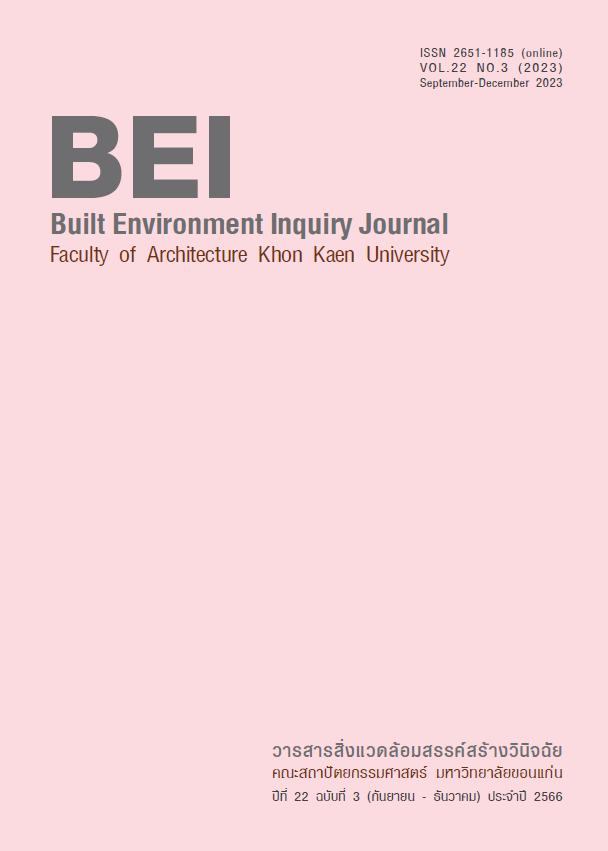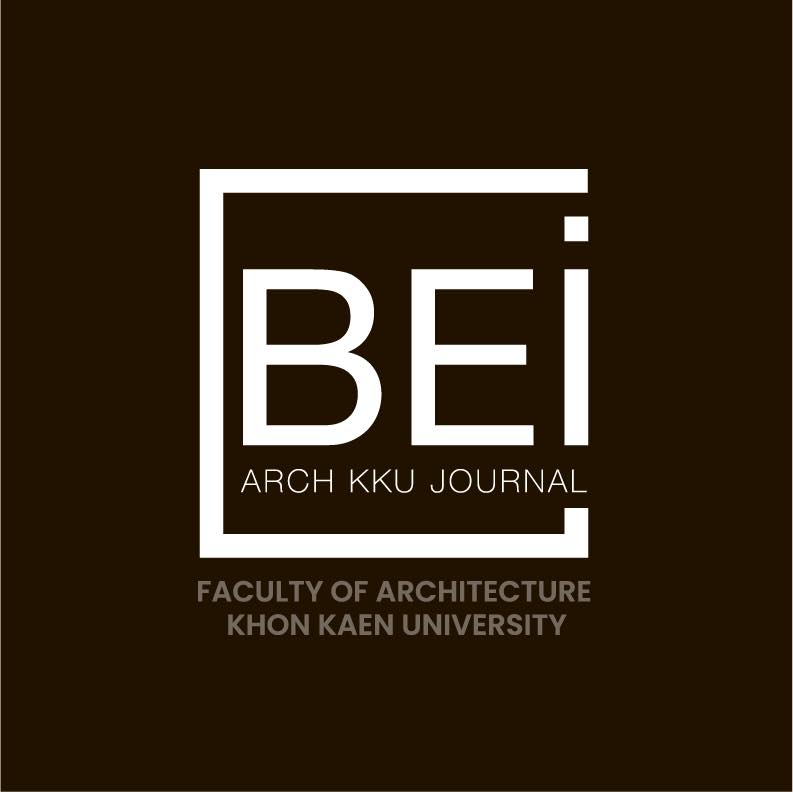การทบทวนวรรณกรรมอย่างเป็นระบบในการพัฒนาพื้นที่รอบสถานีขนส่ง (TOD) (ปี พ.ศ.2540-2564)
DOI:
https://doi.org/10.14456/bei.2023.22คำสำคัญ:
การวิเคราะห์บรรณานุกรม, การพัฒนาที่ยั่งยืน, การพัฒนาพื้นที่บริเวณรอบสถานีขนส่ง, การพัฒนาพื้นที่บริเวณรอบสถานีขนส่งมวลชนที่ยั่งยืนบทคัดย่อ
การพัฒนาพื้นที่รอบสถานีขนส่งมวลชนระบบราง (Transit Oriented Development, TOD) เป็นหนึ่งใน
แนวทางที่สำคัญสำหรับการพัฒนาที่ยั่งยืน (Sustainable Development, SD) อย่างไรก็ตามยังไม่มีใครกล่าวถึง
การวิเคราะห์วิวัฒนาการของการพัฒนาพื้นที่รอบสถานีขนส่งมวลชนระบบรางกับการพัฒนาที่ยั่งยืนร่วมกัน (STOD)
จึงจำเป็นต้องระบุช่องว่างของความรู้หรือแนวโน้มการพัฒนาในด้านนี้ บทความนี้ได้ทำการทบทวนวรรณกรรมอย่าง
เป็นระบบ โดยนำข้อมูลจากฐานข้อมูล Scopus ระหว่างปี พ.ศ. 2540-2564 โดยศึกษางานวิจัยที่เกี่ยวข้องมากถึง
169 ฉบับและวิเคราะห์ด้วย ซอฟต์แวร์ VOSviewer ในการจัดกลุ่มองค์ความรู้และการเปลี่ยนแปลงของพัฒนาการ
ด้านการวิจัยประเภทนี้ตั้งแต่อดีตจนถึงปัจจุบัน ผลการวิจัยพบว่า 1.บทความที่มีการพัฒนาพื้นที่บริเวณรอบสถานี
ขนส่งที่ยั่งยืนในชื่อเพิ่มขึ้นจาก 1 ในปี พ.ศ.2540 ไปเป็น 103 ในปี พ.ศ.2564 2.วารสารที่มีบทความตีพิมพ์มากที่สุด
คือวารสาร Sustainability (Switzerland) รอ้ ยละ 18.2 3.บทความทีมี่การอา้ งองิ สงู สดุ ชื่อ “Suburbanization and
transit-oriented development in China” จำนวน 195 ครั้ง 4.ผู้เขียนที่มีการอ้างอิงมากที่สุด คือ Cervero,
Robert จำนวน 534 ครั้ง 5.กลุ่มสีของคำสำคัญแบ่งเป็น 4 กลุ่มคือ “Urban Development” จำนวน 42 ครั้ง
“Transportation Development” จำนวน 36 ครั้ง “Land Use” จำนวน 33 ครั้ง “Urban Growth” จำนวน 20
ครั้ง 6. วิวัฒนาการของการเปลี่ยนแปลงของ STOD ใน 25ปี แบ่งออกเป็น 3 ระยะ โดยระยะแรก (พ.ศ.2540-2544)
จะเน้นการวางแผนเมือง ระยะที่ 2 (พ.ศ.2545-2554) เน้นด้านการใช้ที่ดิน และระยะที่ 3 (พ.ศ.2555-2564) มุ่งเน้น
ในด้านการพัฒนาเมือง สรุปได้ว่าในความแตกต่างของวิวัฒนาการ (TOD) กับ (STOD) ในช่วง 25 ปี มีความเหมือน
กันของคำสำคัญอยู่ 8 รายการ คือ 1) Transportation Development 2) Urban Development 3) Urban
Planning 4) Urban Transport 5) Transportation Planning 6) Public Transport 7) Land Use และ 8) Travel Behavior สามารถเรียกได้ว่าเป็นแกนหลักสำคัญของ TOD และ STOD แต่มีความแตกต่างที่มิติการมอง
ของมุมมองหลักไม่เหมือนกันกล่าวคือ มิติการพัฒนาพื้นที่รอบสถานีขนส่ง (TOD) จะเน้นมุมมองไปที่ “Transportation
Development” ส่วนมิติวิวัฒนาการพัฒนาพื้นที่รอบสถานีขนส่งที่ยั่งยืน (STOD) จะเน้นมุมมองไปที่ “Urban
Development” การวิจัยนี้ชี้ให้เห็นว่าการพัฒนาพื้นที่บริเวณรอบสถานีขนส่งที่ยั่งยืน (STOD) ในรอบ 25 ปี เป็นแนว
โน้มการเปลี่ยนแปลงที่ทั่วโลกให้การยอมรับตามผลของการวิจัยนี้ และอนาคตควรใช้ STOD ในทุกประเทศ โดยเฉพาะ
อย่างยิ่งกลุ่มประเทศกำลังพัฒนาที่ควรต้องนำปัจจัยและตัวชี้วัดนี้ไปใช้ในการพัฒนาหรือปรับปรุงโครงสร้างของเมือง
เพื่อให้มีความสอดคล้องกับมาตรฐานสากล
เอกสารอ้างอิง
Ali, L., Nawaz, A., Iqbal, S., Aamir Basheer, M., Hameed, J., Albasher, G., Shah, S. A. R., & Bai, Y. (2021). Dynamics of transit oriented development, role of greenhouse gases and urban environment: A study for management and policy. Sustainability (Switzerland), 13(5), 1–14. https://doi.org/10.3390/su13052536
AL-Mohannadi, A. S., & Furlan, R. (2018). The practice of city planning and design in the Gulf Region: Ths Abu Dhabi, Doha And Manama. Archnet-IJAR, 12(2), 126–145. https://doi.org/10.26687/archnet-ijar.v12i2.1460
Appleyard, B. S., Frost, A. R., & Allen, C. (2019). Are all transit stations equal and equitable? Calculating sustainability, livability, health, & equity performance of smart growth & transit-oriented-development (TOD). Journal of Transport and Health, 14(June), 100584. https://doi.org/10.1016/j.jth.2019.100584
Berawi, M. A., Saroji, G., Iskandar, F. A., Ibrahim, B. E., Miraj, P., & Sari, M. (2020). Optimizing land use allocation of transit-oriented development (TOD) to generate maximum ridership. Sustainability (Switzerland), 12(9), 1–20. https://doi.org/10.3390/su12093798
Bertolini, L. (1996). Nodes and places: Complexities of railway station redevelopment. European Planning Studies, 4(3), 331–345. https://doi.org/10.1080/09654319608720349
Bertolini, L., Curtis, C., & Renne, J. (2012). Station area projects in Europe and beyond: Towards transit oriented development? Built Environment, 38(1), 31–50. https://doi.org/10.2148/benv.38.1.31
Boussauw, K., van Meeteren, M., Sansen, J., Meijers, E., Storme, T., Louw, E., Derudder, B., & Witlox, F. (2018). Planning for agglomeration economies in a polycentric region: Envisioning an efficient metropolitan core area in Flanders. European Journal of Spatial Development, 69, 1–26. https://doi.org/10.30689/EJSD2018:69.1650-9544
Calthorpe, P. (1993). The Next American Metropolis: Ecology, Community, and the American Dream. Princeton Architectural Press.
Carnahan, S., Agarwal, R., & Campbell, B. (2010). The Effect of Firm Compensation Structures on the Mobility and Entrepreneurship of Extreme Performers. Business, 920(October), 1–43. https://doi.org/10.1002/smj
Caset, F., Blainey, S., Derudder, B., Boussauw, K., & Witlox, F. (2020). Integrating node-place and trip end models to explore drivers of rail ridership in Flanders, Belgium. Journal of Transport Geography, 87(September 2019), 102796. https://doi.org/10.1016/j.jtrangeo.2020.102796
Cervero, R. (1998). The Transit Metropolis: A Global Inquiry. In Island Press, Washington, DC. (Issue 1). https://doi.org/10.5070/bp314112990
Cervero, R., & Dai, D. (2014). BRT TOD: Leveraging transit oriented development with bus rapid transit investments. Transport Policy, 36, 127–138. https://doi.org/10.1016/j.tranpol.2014.08.001
Cervero, R., & Day, J. (2008). Suburbanization and transit-oriented development in China. Transport Policy, 15(5), 315–323. https://doi.org/10.1016/j.tranpol.2008.12.011
Cervero, R., & Kockelman, K. (1997). Travel demand and the 3Ds: Density, diversity, and design. Transportation Research Part D: Transport and Environment, 2(3), 199–219. https://doi.org/10.1016/S1361-9209(97)00009-6
Cervero, R., & Sullivan, C. (2011). Green TODs: Marrying transit-oriented development and green urbanism. International Journal of Sustainable Development and World Ecology, 18(3), 210–218. https://doi.org/10.1080/13504509.2011.570801
Chatziioannou, I., Alvarez-Icaza, L., Bakogiannis, E., Kyriakidis, C., & Chias-Becerril, L. (2020). A structural analysis for the categorization of the negative externalities of transport and the hierarchical organization of sustainable mobility’s strategies. Sustainability (Switzerland), 12(15), 1–27. https://doi.org/10.3390/su12156011
Congress for the New Urbanism. (2022). Charter of the New Urbanism. Congress for the New Urbanism. From Https://Www.Cnu.Org/Who-Weare/Charter-New-Urbanism.
de la Espriella, C. (2007). Designing for equality: Conceptualising a tool for strategic territorial planning. Habitat International, 31(3–4), 317–332. https://doi.org/10.1016/j.habitatint.2007.04.003
Dorsey, B., & Mulder, A. (2013). Planning, place-making and building consensus for transit-oriented development: Ogden, Utah case study. Journal of Transport Geography, 32, 65–76. https://doi.org/10.1016/j.jtrangeo.2013.08.010
Duncan, M. (2011). The impact of transit-oriented development on housing prices in San diego, CA. Urban Studies, 48(1), 101–127. https://doi.org/10.1177/0042098009359958
Huang, R., Moudon, A. v., Zhou, C., Stewart, O. T., & Saelens, B. E. (2017). Light rail leads to more walking around station areas. Journal of Transport and Health, 6, 201–208. https://doi.org/10.1016/j.jth.2017.02.002
Huang, X., Cao, X. (Jason), Yin, J., & Cao, X. (2017). Effects of metro transit on the ownership of mobility instruments in Xi’an, China. Transportation Research Part D: Transport and Environment, 52, 495–505. https://doi.org/10.1016/j.trd.2016.09.014
Iamtrakul, P., Kongphunphin, C., & Horayangkura, V. (2013). An Evaluation Framework for Sustainable Development : The Challenge for Planners and Development. Journal of Architectural/Planning Research and Studies (JARS), 1(10), 85–106.
Iamtrakul, P., Padon, A., & Klaylee, J. (2022). The Study on Association between Urban Factors and Walkability of Transit Oriented Development (TOD). GMSARN International Journal, 16(4), 388–398.
Iamtrakul, P., & Raungratanaamporn, I. (2015). Sustainable Campus Town Development in Suburban Area of Bangkok, Thailand. International Journal of Building, Urban, Interior and Landscape Technology (BUILT), (6), 39–52.
Iamtrakul, P., Raungratanaamporn, I., Klaylee, J., & Chayphong, S. (2021). The Walkability Of Transit Oriented Development ( Tod ): A Case Study Of Bangkok Metropolitan , Thailand. Lowland Technology International, 22(September), 181–192. https://cot.unhas.ac.id/journals/index.php/ialt_lti/article/view/772
Iamtrakul, P., Raungratanaamporn, I., & Shinpiriya, P. (2017). Framework of planning and policy analysis for Transit Oriented Development (TOD) towards Sustainable Urban Development. Journal of Architectural/Planning and Studies (JAR), 14(1), 95–122.
Iamtrakul, P., & Zhang, J. (2014). Measuring pedestrians’ satisfaction of urban environment under transit oriented development (TOD): A case study of Bangkok Metropolitan, Thailand. Lowland Technology International, 16(2), 125–134. https://doi.org/10.14247/lti.16.2_125
Jaeger, C. (2018). Limits to growth. Encyclopedia of Ecology, 367–369. https://doi.org/10.1016/B978-0-444-63768-0.00630-2
Journal of Transport Geography. (n.d.). Available online: https://www.sciencedirect.com/journal/journal-of-transport-geography.
Kamruzzaman, M., Baker, D., Washington, S., & Turrell, G. (2014). Advance transit oriented development typology: Case study in brisbane, australia. Journal of Transport Geography, 34, 54–70. https://doi.org/10.1016/j.jtrangeo.2013.11.002
Kasioumi, E. (2011). Sustainable urbanism: Vision and planning process through an examination of two model neighborhood developments. Berkeley Planning Journal, 24(1), 91–114. https://doi.org/10.5070/bp324111867
Ke, L., Furuya, K., & Luo, S. (2021). Case comparison of typical transit-oriented-development stations in Tokyo district in the context of sustainability: Spatial visualization analysis based on FAHP and GIS. Sustainable Cities and Society, 68(February). https://doi.org/10.1016/j.scs.2021.102788
Khare, R., Villuri, V. G. K., & Chaurasia, D. (2021). Urban sustainability assessment: The evaluation of coordinated relationship between BRTS and land use in transit-oriented development mode using DEA model. Ain Shams Engineering Journal, 12(1), 107–117. https://doi.org/10.1016/j.asej.2020.08.012
Langlois, M., Wasfi, R. A., Ross, N. A., & El-Geneidy, A. M. (2016). Can transit-oriented developments help achieve the recommended weekly level of physical activity? Journal of Transport and Health, 3(2), 181–190. https://doi.org/10.1016/j.jth.2016.02.006
Li, J., & Huang, H. (2020). Effects of transit-oriented development (TOD) on housing prices: A case study in Wuhan, China. Research in Transportation Economics, 80(December 2019), 100813. https://doi.org/10.1016/j.retrec.2020.100813
Li, Z., Han, Z., Xin, J., Luo, X., Su, S., & Weng, M. (2019). Transit oriented development among metro station areas in Shanghai, China: Variations, typology, optimization and implications for land use planning. Land Use Policy, 82(129), 269–282. https://doi.org/10.1016/j.landusepol.2018.12.003
Ma, X., Chen, X., Li, X., Ding, C., & Wang, Y. (2018). Sustainable station-level planning: An integrated transport and land use design model for transit-oriented development. Journal of Cleaner Production, 170, 1052–1063. https://doi.org/10.1016/j.jclepro.2017.09.182
Moher, D., Liberati, A., Tetzlaff, J., & Altman, D. G. (2009). Academia and Clinic Annals of Internal Medicine Preferred Reporting Items for Systematic Reviews and Meta-Analyses : Annals of Internal Medicine, 151(4), 264–269.
Mu, R., & de Jong, M. (2012). Establishing the conditions for effective transit-oriented development in China: the case of Dalian. Journal of Transport Geography, 24, 234–249. https://doi.org/10.1016/j.jtrangeo.2012.02.010
Newman, P. (n.d.). Transit Oriented Development: An Australian Overview.
Newman, P., & Kenworthy, J. (1999). Sustainability and Cities: Overcoming Automobile Dependence.
Niu, S., Hu, A., Shen, Z., Lau, S. S. Y., & Gan, X. (2019). Study on land use characteristics of rail transit TOD sites in new towns—taking Singapore as an example. Journal of Asian Architecture and Building Engineering, 18(1), 19–30. https://doi.org/10.1080/13467581.2019.1586712
Norley, K. (2015). Developing the ‘Ds’ – Predicting mode share from urban structure. ATRF 2015 - Australasian Transport Research Forum 2015, Proceedings, October, 1–15.
Ogra, A. (2014). The Role of 6Ds: Density, Diversity, Design, Destination, Distance, and Demand Management in Transit Oriented Development (TOD). https://www.researchgate.net/publication/268813431
Ollivier, Gerald, Ghate, Ashish, Bankim, Kalra, Mehta, & Prerna. (2021). Transit-Oriented Development Implementation Resources and Tools (2nd Edition). www.worldbank.org
Padon, A., & Iamtrakul, P. (2021). Grouping Areas Around Rail Transport Stations Based on the Concept Transit Oriented Development (TOD): The Green Line (Mo Chit–Onnut) and the Blue Line (Bang Sue–Hua Lamphong). The Journal of King Mongkut’s University of Technology North Bangkok, 31(3), 587–596. https://doi.org/10.14416/j.kmutnb.2021.05.020
Pan, H., Shen, Q., & Liu, C. (2011). Transit-oriented development at the urban periphery. Transportation Research Record, 2245, 95–102. https://doi.org/10.3141/2245-12
Papa, E., & Bertolini, L. (2015). Accessibility and Transit-Oriented Development in European metropolitan areas. Journal of Transport Geography, 47, 70–83. https://doi.org/10.1016/j.jtrangeo.2015.07.003
Park, K., Ewing, R., Scheer, B. C., & Tian, G. (2018). The impacts of built environment characteristics of rail station areas on household travel behavior. Cities, 74(August), 277–283. https://doi.org/10.1016/j.cities.2017.12.015
Pezeshknejad, P., Monajem, S., & Mozafari, H. (2020). Evaluating sustainability and land use integration of BRT stations via extended node place model, an application on BRT stations of Tehran. Journal of Transport Geography, 82(December 2019), 102626. https://doi.org/10.1016/j.jtrangeo.2019.102626
Singh, Y. J., Fard, P., Zuidgeest, M., Brussel, M., & Maarseveen, M. van. (2014). Measuring transit oriented development: A spatial multi criteria assessment approach for the City Region Arnhem and Nijmegen. Journal of Transport Geography, 35, 130–143. https://doi.org/10.1016/j.jtrangeo.2014.01.014
Singh, Y. J., Lukman, A., Flacke, J., Zuidgeest, M., & van Maarseveen, M. F. A. M. (2017a). Measuring TOD around transit nodes - Towards TOD policy. Transport Policy, 56(February), 96–111. https://doi.org/10.1016/j.tranpol.2017.03.013
Singh, Y. J., Lukman, A., Flacke, J., Zuidgeest, M., & van Maarseveen, M. F. A. M. (2017b). Measuring TOD around transit nodes - Towards TOD policy. Transport Policy, 56, 96–111. https://doi.org/10.1016/j.tranpol.2017.03.013
Stevens, J., Plowright, P., & Adhya, A. (2010). Defining Sustainable Urbanism: towards a responsive urban design. https://www.researchgate.net/publication/256079248
Su, S., Zhang, H., Wang, M., Weng, M., & Kang, M. (2021). Transit-oriented development (TOD) typologies around metro station areas in urban China: A comparative analysis of five typical megacities for planning implications. Journal of Transport Geography, 90(129), 102939. https://doi.org/10.1016/j.jtrangeo.2020.102939
Su, S., Zhang, J., He, S., Zhang, H., Hu, L., & Kang, M. (2021). Unraveling the impact of TOD on housing rental prices and implications on spatial planning: A comparative analysis of five Chinese megacities. Habitat International, 107(129), 102309. https://doi.org/10.1016/j.habitatint.2020.102309
Sun, Z., Allan, A., Zou, X., & Scrafton, D. (2022). Scientometric Analysis and Mapping of Transit-Oriented Development Studies. Planning Practice and Research, 37(1), 35–60. https://doi.org/10.1080/02697459.2021.1920724
Sustainability (Switzerland). (n.d.). Available online: https://www.mdpi.com/journal/sustainability.
Suzuki, H., Cervero, R., & Iuchi, K. (2013). Transforming Cities with Transit. In Transforming Cities with Transit. The World Bank. https://doi.org/10.1596/978-0-8213-9745-9
Üsdiken, B., & Pasadeos, Y. (1995). Organizational Analysis in North America and Europe: A Comparison of Co-citation Networks. Organization Studies, 16(3), 503–526. https://doi.org/10.1177/017084069501600306
Vale, D. S. (2015). Transit-oriented development, integration of land use and transport, and pedestrian accessibility: Combining node-place model with pedestrian shed ratio to evaluate and classify station areas in Lisbon. Journal of Transport Geography, 45, 70–80. https://doi.org/10.1016/j.jtrangeo.2015.04.009
van Eck, N. J., & Waltman, L. (2017). Citation-based clustering of publications using CitNetExplorer and VOSviewer. Scientometrics, 111(2), 1053–1070. https://doi.org/10.1007/s11192-017-2300-7
Wey, W. M., Zhang, H., & Chang, Y. J. (2016). Alternative transit-oriented development evaluation in sustainable built environment planning. Habitat International, 55, 109–123. https://doi.org/10.1016/j.habitatint.2016.03.003
White, H. D., & McCain, K. W. (1998). Visualizing a discipline: An author co-citation analysis of information science, 1972-1995. Journal of the American Society for Information Science, 49(4), 327–355. https://doi.org/10.1002/(SICI)1097-4571(19980401)49:4<327::AID-ASI4>3.0.CO;2-W
Zupic, I., & Čater, T. (2015). Bibliometric Methods in Management and Organization. Organizational Research Methods, 18(3), 429–472. https://doi.org/10.1177/1094428114562629
ดาวน์โหลด
เผยแพร่แล้ว
รูปแบบการอ้างอิง
ฉบับ
ประเภทบทความ
สัญญาอนุญาต
ลิขสิทธิ์ (c) 2023 สิ่งแวดล้อมสรรค์สร้างวินิจฉัย

อนุญาตภายใต้เงื่อนไข Creative Commons Attribution-NonCommercial-NoDerivatives 4.0 International License.
ทัศนะและข้อคิดเห็นของบทความที่ปรากฏในวารสารฉบับนี้เป็นของผู้เขียนแต่ละท่าน ไม่ถือว่าเป็นทัศนะและความรับผิดชอบของกองบรรณาธิการ




